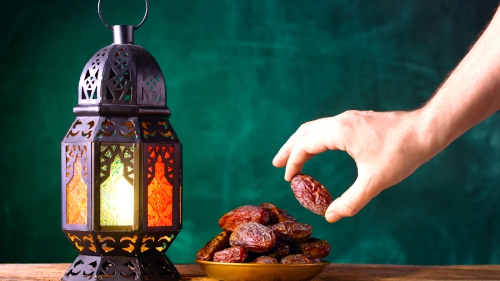Are 300 Recipes Enough to Counter Anti-Muslim Sentiment?

Before Syria was devastated by war, its population displaced and ancient cities ruined, Anissa Helou would show visitors a different side to the country. Starting in Damascus, her tour groups wove northeast through Bosra and Palmyra, admiring the sites before entering Aleppo, a city she would showcase as the Middle East’s “gastronomic capital.”
Seven years later, the celebrated food writer’s new cookbook, “Feast,” pays homage to the city from the get-go, its cover adorned with a picture of its lamb and sour cherry kebab piled among pine nuts and crisp shards of bread.
[Make the recipe: Malabar Chicken Biryani]
The book is Helou’s ninth, and a veritable compendium, with more than 300 recipes. Taken together, the recipes chronicle how a history of trade routes and migration throughout the Islamic world plays out on the dinner table, from simple suppers to festival fare.
It was not until summer 1992 that she thought for the first time of writing a cookbook, the notion striking her one afternoon as she sat at the dinner table with Lebanese friends displaced by the country’s civil war. “It occurred to me then to write a book for all the young people who did not get the chance to experience Lebanese food like I had,” she recalled.
The upper-middle-class Helou household came alive on cooking days. Fish vendors and milkmen brought their freshest produce to the door. Street carts were piled with fruit. “You were just immersed in food,” she said. “Cooking with your mother and your grandmother, you saw everything.”
“Lebanese Cuisine,” the book that followed, went on to win international acclaim, bringing the dishes of Lebanon to a global audience in much the same way that Madhur Jaffrey has done for Indian food and Edna Lewis for that of America’s South.
[Aleppo, in our hearts and in the kitchen]
Although Helou herself isn’t Muslim, decades of experience have made her a rare authority on Islamic regions’ cuisines. In the back-cover-blurb words of London chef-author Yotam Ottolenghi, she is “just the kind of cook you want by your side when baking a Moroccan flatbread.”
As Naomi Duguid, the celebrated food writer and author of “Taste of Persia,” put it, “We need more books like this. Writing about the food of other cultures with respect and empathy is important, because it’s an entry point. We all have to eat. This gives a sense of the rich range and also the interconnectedness of everything people are eating.”
Against the backdrop of wars in the Middle East and President Trump’s travel ban for residents of five Muslim-majority countries, Helou sees the publication of “Feast” as a political act. “The Islamic world has such a rich history that I wanted to do something to portray its positive side,” she said. “Especially in this moment, it felt important.”
On trip after trip, she found that food offered a way to connect with the lives of strangers, with the simplest of inquiries yielding surprising encounters. In Aleppo, before the war, a chance meeting with a group of heavily covered women ended with tea and date-stuffed sweets in their home. In Dakar, it led her to a former prime minister’s home, where she dined on Senegal’s national dish of thieboudienne. The version that made it into “Feast” features whole grouper or sea bream laced with a spicy marinade of parsley and Aleppo peppers.

Arabian Meat and Vegetable Stew (Tharid), from “Feast.” (Kristin Perers/Ecco/HarperCollins Publishers)
“Feast” is also a testament to how recipes can morph from country to country, or even between cities, as spices are added and techniques change. Unable to pick just one, Helou offers recipes for seven biryanis, from the slow-cooked, one-pot dish of Hyderabad to a Kolkata variation with potatoes. Even the United Arab Emirates has a version, albeit with fewer spices and no meat. “You could see the commonalities, but each time it’s different, wonderful,” Helou said.
[A Muslim cook wanted to stop the hate. So she started inviting strangers to dinner.]
But it is the food of the Levant — particularly Lebanon and Syria — for which the book reserves the greatest affection, with references to the grilled Syrian kibbe that Helou ate during childhood visits to her aunt’s house in the town of Mashta al-Helou, and a sumac version she ate with friends in Aleppo’s Old City.
But as in centuries and decades before, the city is already rebuilding, and even outside Syria’s borders, mass displacement has caused the recipes found along Helou’s onetime culinary tour route to proliferate, as families now share them in exile.
Even in the refugee camps of Jordan, Lebanon and Turkey, groups of Syrian women gather each evening to prepare the meals of their homeland, some working on a steady production line, others bickering over the best recipes to adopt.
“There is something about the cuisine of these places there that is almost mythical, because of how many cultures have passed through them,” she said. Her favorite meal, even after years of traveling the world, is still Aleppo’s glistening sour cherry kebab.
6 to 8 servings
The ingredient list is on the long side, but the prep and cooking go fairly fast. The garam masala blend suggested for this recipe includes mace, cinnamon and green cardamom; if you’re game to make it from scratch, see the NOTE, below.
MAKE AHEAD: The golden raisins need to be soaked in water for an hour or two.
Adapted from “Feast: Food of the Islamic World,” by Anissa Helou (HarperCollins, 2018).
⅓ cup golden raisins
Generous pinch of saffron threads
2 tablespoons rose water
½ cup ghee or vegetable oil
4 small onions (about 14 ounces total), halved and cut into thin wedges
3 or 4 mild green chile peppers, seeded and minced (2 ounces total)
One 2-inch piece peeled fresh ginger root, minced
6 cloves garlic, minced to a paste
½ teaspoon poppy seeds, finely crushed
2 Cornish hens, cut into quarters (about 3¼ pounds total; may substitute 1 whole chicken of that weight, cut into 8 pieces)
Sea salt
⅔ cup plain full-fat yogurt
3 cups water
Juice of 1 lime, or more as needed
⅓ cup unsalted cashews, coarsely chopped
2½ cups long-grain rice
1 teaspoon garam masala (see headnote and NOTE)
A few sprigs cilantro, coarsely chopped (leaves and tender stems; may substitute mint), for garnish
Place the raisins in a small bowl; cover with water and soak for an hour or two, then drain.
Place the saffron threads in a small bowl and add the rose water; let them soak.
Heat half the ghee or oil in a large pot over medium heat. Add half the onions; cook for about 5 minutes, then add the chiles, ginger, garlic and crushed poppy seeds; cook for a few minutes, until fragrant.
Season the poultry pieces lightly with salt all over, then nestle into the pot, skin sides down. Cook for a few minutes, until lightly browned. Use tongs to turn them over; they will not be cooked through.
Add the yogurt and ¼ cup of the water, stirring to incorporate. Reduce the heat to low; cover and cook for 15 minutes, then add the lime juice and another ¼ cup of water; cover and cook for 15 minutes or until the chicken is cooked through and the liquids have thickened into a sauce. Turn off the heat.
Meanwhile, heat the remaining ghee or oil in a skillet or saute pan over medium heat. Add the remaining onions and cook for about 7 minutes, stirring a few times, until lightly golden and soft. Stir in the drained raisins and cashews; cook for 3 minutes, then use a slotted spoon to transfer the mixture to a plate, leaving some oil in the pan.
Rinse the rice under cool water and drain well, then add to the same pan you used for the cashew mixture. Stir to coat with the fat in the pan; cook for few minutes, then add the remaining 2½ cups of water. Increase the heat to medium-high; once the liquid boils, reduce the heat to medium-low and cook for 10 to 15 minutes, or until the rice is tender and has absorbed the water. Remove from the heat.
Warm up the pot with chicken and sauce, over low heat. Sprinkle ¼ teaspoon of the garam masala over the chicken, then fluff the rice in the pan with a fork and spread a third of it over the chicken and sauce. Drizzle 2 teaspoons of the saffron-infused rose water evenly over the layer of rice. Spread half the cashew mixture over the top.
Sprinkle another ¼ teaspoon of garam masala over the surface of the mixture, then cover with another third of the cooked rice. Sprinkle with another 2 teaspoons of saffron water and add another layer of the cashew mixture.
Add the final layer of rice. Sprinkle the remaining saffron water and another ¼ teaspoon of garam masala over the top. Wrap a clean kitchen towel around the pot lid (to absorb any condensation) and cover the pot with it. Cook on the lowest heat setting for about 20 minutes. Taste, and add more salt, as needed.
Transfer the rice to a serving platter, arranging the chicken pieces atop the biryani rice. Garnish with the cilantro. Serve hot.
NOTE: To make Anissa Helou’s garam masala for this dish, combine ¼ cup anise seed, ¼ cup caraway seed, ¼ cup cumin seed, 2 tablespoons green cardamom pods, 2 tablespoons whole cloves, two 3-inch easy-to-shred cinnamon sticks, 2 whole nutmegs and a few shards of mace in a skillet over medium heat. Cook for a minute or two, until fragrant. Let cool, then transfer to a dedicated spice grinder and pulse until finely ground. The yield is about 1¼ cups; store in a glass jar for up to 1 year.
( Source: Washington Post )





















